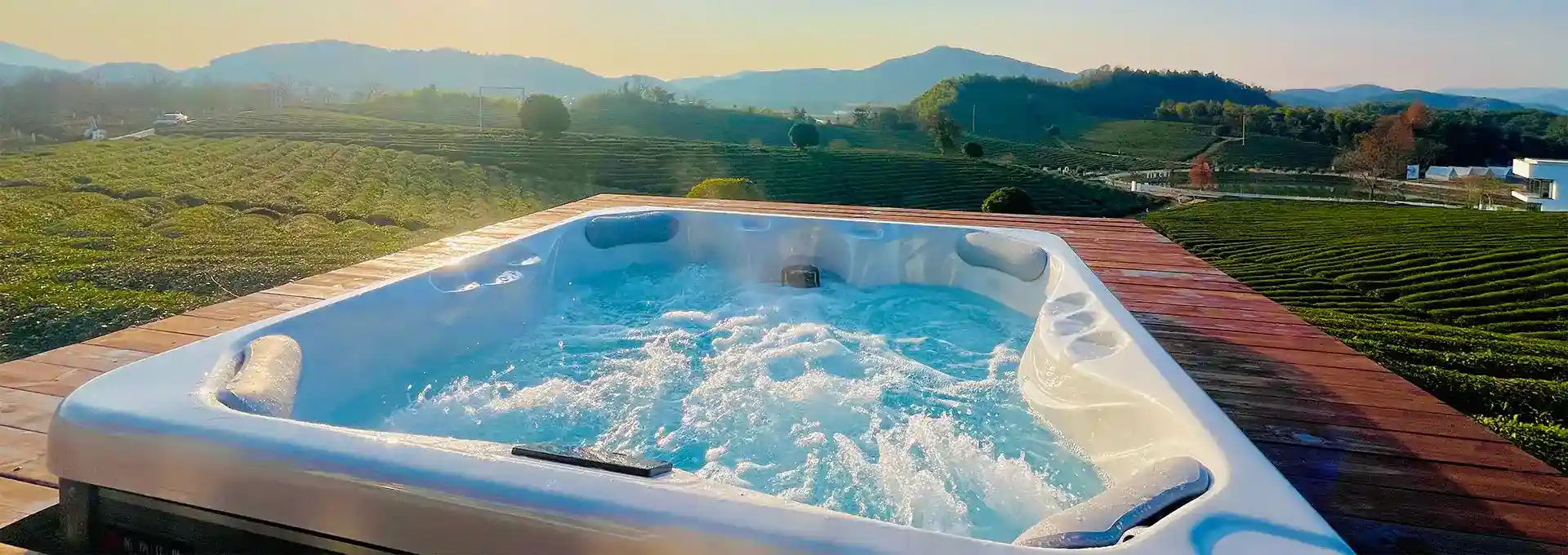Can a Balcony Hold a Hot Tub?
2024-10-24 15:31:52
Balconies are often seen as an extension of our living spaces, offering fresh air and outdoor views. But what if you want to take your balcony experience to the next level by adding a hot tub? The question "Can a balcony hold a hot tub?" is more complex than it might seem at first glance. Let's dive into this topic and explore the possibilities and considerations of installing a hot tub on your balcony.
How Much Weight Can a Balcony Support?
When considering adding a hot tub to your balcony, the first and most crucial factor to consider is the weight capacity of your balcony. Balconies are designed to support a specific load, which varies depending on the building's construction, age, and local building codes.
Typically, residential balconies are required to support a minimum live load of 40-60 pounds per square foot (psf). However, this can vary significantly based on location and building specifications. For example, some modern buildings might have balconies designed to support up to 100 psf or more.
To put this into perspective, let's consider the weight of a hot tub. An average 4-person hot tub, when filled with water and occupied, can weigh between 3,000 to 5,000 pounds. This weight is distributed over the area of the hot tub, which is typically around 30-40 square feet. This means the load on the balcony could be as high as 125-166 psf, significantly exceeding the standard design load for most residential balconies.
Before even considering installing a hot tub on your balcony, it's crucial to consult with a structural engineer. They can assess your balcony's specific load capacity and determine if it's capable of safely supporting a hot tub. In many cases, reinforcement of the balcony structure may be necessary, which could involve additional support beams, strengthened flooring, or other structural modifications.
It's also important to consider the dynamic load. When people move in and out of the hot tub or when the water is agitated, it creates additional stress on the structure. This dynamic load needs to be factored into the overall weight calculations.
Remember, the safety implications of exceeding a balcony's weight capacity are severe. An overloaded balcony could collapse, leading to serious injuries or worse. Always prioritize safety and consult professionals before proceeding with such a significant addition to your balcony.
What Are the Legal Requirements for Installing a Hot Tub on a Balcony?
The legal aspects of installing a hot tub on a balcony are just as important as the structural considerations. Navigating these requirements can be complex, as they often involve multiple layers of regulations and permissions.
First and foremost, check your local building codes. Many municipalities have specific regulations regarding balcony modifications and the installation of water-containing structures on elevated surfaces. These codes often specify load requirements, electrical safety standards, and water drainage regulations. Some areas may outright prohibit the installation of hot tubs on balconies due to safety concerns.
If you live in an apartment or condominium, you'll need to review your lease agreement or homeowners' association (HOA) bylaws. Many of these documents have clauses that restrict major balcony modifications or the addition of heavy items like hot tubs. Even if not explicitly mentioned, such installations often require approval from the landlord or HOA board.
Insurance is another crucial legal consideration. Adding a hot tub to your balcony may affect your home insurance policy. Some insurers may increase your premiums due to the added risk, while others might require additional coverage. In some cases, insurers may even refuse to cover damages related to the hot tub if it's installed on a balcony. It's essential to discuss these changes with your insurance provider before proceeding with the installation.
Permits are often required for such significant modifications. You may need to obtain permits for structural changes, electrical work, and plumbing modifications. The permitting process usually involves submitting detailed plans of the proposed installation, which will be reviewed by local authorities to ensure compliance with building codes and safety standards.
Privacy and nuisance laws should also be considered. In urban areas, a balcony hot tub might raise concerns about privacy infringement or noise disturbance for neighboring properties. Be aware of local ordinances regarding noise levels and privacy screens.
Lastly, if you're renting, remember that such a significant modification would almost certainly require explicit permission from your landlord. Even if you own your apartment, you may need approval from the building management or co-op board.
Given the complexity of these legal requirements, it's advisable to consult with a local attorney specializing in property law. They can help you navigate the specific regulations in your area and ensure that your hot tub installation complies with all relevant laws and regulations.
How Do You Maintain an Outdoor Hot Tub?
Maintaining an outdoor hot tub, especially one on a balcony, requires dedication and regular attention to ensure it remains clean, safe, and enjoyable. Proper maintenance not only extends the life of your hot tub but also ensures a hygienic environment for users.
Water quality is paramount in hot tub maintenance. Unlike a swimming pool, the small volume of water in a hot tub can quickly become contaminated if not properly treated. Regular testing of the water's pH and sanitizer levels is crucial. Most hot tub owners test their water 2-3 times a week using test strips or a digital tester. The ideal pH range for a hot tub is between 7.2 and 7.8, while the recommended chlorine level is 1-3 parts per million (ppm) or 2-4 ppm for bromine.
Sanitizing the water is essential to prevent the growth of bacteria and algae. While chlorine is a popular choice, many outdoor hot tub owners prefer bromine as it's more stable in hot water and less affected by sunlight. Regardless of the sanitizer you choose, it's important to shock the hot tub weekly. Shocking involves adding a high dose of sanitizer to break down organic contaminants and reset the water chemistry.
Filtration is another crucial aspect of hot tub maintenance. The filter catches debris and contaminants, keeping the water clean. Most hot tubs circulate water through the filter for several hours each day. The filter should be cleaned every 2-4 weeks, depending on usage, and replaced annually. For a balcony hot tub, you might need to clean the filter more frequently due to increased exposure to outdoor elements.
Water changes are necessary even with regular maintenance. Typically, the water in a hot tub should be changed every 3-4 months. However, for a balcony hot tub that might see more frequent use or exposure to outdoor contaminants, more frequent changes might be necessary. When changing the water, it's an excellent opportunity to clean the tub's surface thoroughly.
Speaking of cleaning, the hot tub shell and cover require regular attention. The shell should be wiped down weekly with a soft cloth and a non-abrasive cleaner designed for hot tubs. Pay special attention to the waterline where oils and debris can accumulate. The cover should be cleaned monthly with a vinyl cleaner and conditioner to prevent cracking and extend its life.
For a balcony hot tub, protection from the elements is crucial. A high-quality, well-fitted cover is essential not only for insulation but also to keep out debris, rainwater, and snow. In harsh weather conditions, you might want to consider an additional protective cover or enclosure.
Balcony hot tubs may require additional maintenance due to their exposure. Regular checks for leaks are crucial, as any water damage could affect the balcony structure. Also, be mindful of the drainage system. Ensure that any overflow or splashed water has a proper drainage route that doesn't affect your balcony or the areas below.
Energy efficiency is another consideration for maintaining an outdoor hot tub. Proper insulation, including a well-sealed cover, can significantly reduce heating costs. Regular checks of the heating system and pumps are necessary to ensure they're operating efficiently.
Lastly, winterization might be necessary depending on your climate. If you live in an area with freezing temperatures and don't plan to use the hot tub during winter, you'll need to drain it, blow out the plumbing lines, and properly winterize all components to prevent freeze damage.
While this might seem like a lot of work, many hot tub owners find the maintenance routine to be part of the enjoyment of owning a hot tub. With modern technology, some aspects of maintenance can be automated or simplified. For instance, Shenzhen Iparnassus Intelligent Spas Co., LTD offers hot tubs with advanced circulation and filtration systems that can reduce the frequency of water changes and simplify maintenance.
Shenzhen Iparnassus Intelligent Spas Co., LTD specializes in vacation hot tubs and infinity pool spas, making them an excellent choice for balcony installations. Their hot tubs are equipped with circulation filtration and disinfection systems, reducing the need for frequent water changes. This feature is particularly beneficial for balcony hot tubs where water changes might be more challenging.
The company boasts a professional team dedicated to design, R&D, production, sales, and after-sales service. As of 2023, they have obtained over 30 patents, demonstrating their commitment to innovation in the spa industry. The iParnassus® brand has a global presence, with business coverage in dozens of countries and regions worldwide.
For Middle Eastern hotel bulk purchase cooperation, Shenzhen Iparnassus offers several advantages:
1. Free custom mold opening support
2. Free upgrade of electronic control with hotel centralized management system
3. Direct cooperation with top manufacturers, passing on cost savings directly to hotels
4. North American production materials and standards at competitive prices
Their high-end, quality products and reliable after-sales service have led to sales in over 20 countries worldwide. This global reach and experience make them a reliable choice for those considering a balcony hot tub installation, especially in commercial or hospitality settings.
In conclusion, while installing a hot tub on a balcony is a complex undertaking that requires careful consideration of structural, legal, and maintenance factors, it can be a rewarding addition to your living space when done correctly. Always prioritize safety, comply with local regulations, and choose high-quality products from reputable manufacturers like Shenzhen Iparnassus Intelligent Spas Co., LTD to ensure the best possible experience with your balcony hot tub.
For more information on hot tub installations and our products, please feel free to contact us at info@iparnassus.com.
References:
1. International Building Code (IBC) - Balcony Load Requirements
2. American Society of Civil Engineers (ASCE) - Minimum Design Loads for Buildings and Other Structures
3. National Spa and Pool Institute (NSPI) - Hot Tub and Spa Safety Standards
4. U.S. Consumer Product Safety Commission - Pool and Spa Safety Act
5. Association of Pool & Spa Professionals (APSP) - Hot Tub Maintenance Guidelines
6. Energy.gov - Energy Efficiency in Pool and Spa Equipment
7. National Electric Code (NEC) - Requirements for Outdoor Electrical Equipment
8. World Health Organization (WHO) - Guidelines for Safe Recreational Water Environments
9. Environmental Protection Agency (EPA) - Regulations on Water Drainage and Runoff
10. Shenzhen Iparnassus Intelligent Spas Co., LTD - Official Product Specifications and Company Information



